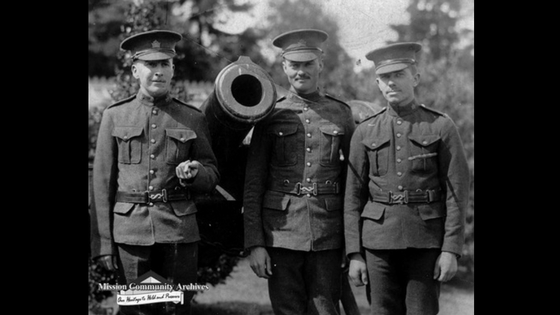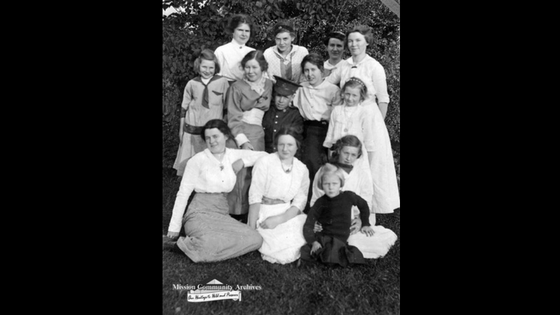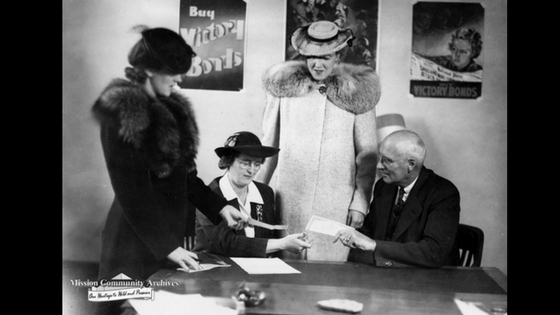Mission at War
World War I
Canada declared war on Germany on August 5, 1914, following the rest of the British Empire who had declared war the previous day. Energized by patriotic fervour, Mission residents rallied to support the War cause. A competition between the municipalities led to the raising of $470 by Mission for a hospital ship. Mission’s own militia, the “C” Company authorized in 1910, became the Mission chapter of the Westminster Regiment (a new organization of the 104th Regiment of Infantry) in 1914. The call to serve the Commonwealth inspired many young men to sign up. Two hundred and seventy men enlisted in Mission with the Westminster Regiment, which had consolidated all chapters in New Westminster by 1917. After vigorous training, the Regiment was sent to England, and from there, to the fighting at the continent. Mission’s soldiers served in some of the bloodiest and historically significant battles of the “Great War”, including at the Somme in 1916, Vimy Ridge, Ypres, and Passchendaele in 1917. At least one woman from Mission, Louisa Collins, enlisted during the First World War to serve with the Army in a non-combat role.
Back home in Mission, residents did all they could to support the war effort and their loved ones overseas. Mission’s branch of the Women’s Institute knitted clothing, preserved hundreds of jars of jam, assembled First Aid kits and “Comfort Packs”, sponsored fundraising concerts, and sold patriotic buttons. Intense fundraising efforts lead to the raising of $110,000 towards a Victory Loan. Men too old to enlist served as members of the Home Guard, in the potential event of a home invasion. The Fraser Valley Record published several popular columns with updates on the movement of men serving overseas, including notices of those MIA or killed. “Letters from the Front” published small snippets of letters sent to friends and families, adding a personal touch to the official propaganda.
Many Mission men never made it back home, dying on the battlefield, or in hospitals in England. Their graves are scattered across France and Flanders, a reminder of the disastrous loss for such a small town. Instead of the usual Cenotaph, the grieving residents of Mission commemorated the dead and honoured the returning soldiers in a unique memorial: the first Mission Memorial Hospital, opened on May 15, 1920 in honour of those who paid the greatest sacrifice. First housed in a two-story building on the corner of 3rd and Birch, the finished hospital was completed five years later, and still stands on 5th and James Street, now as the Memorial Centre.
World War II
On September 10, 1939, Canada declared war on Germany. There was a general misconception that the war would be over by Christmas and, as a result, Mission did not feel its effects immediately. However, fund-raising efforts soon began and were extremely successful. By June 1941, Mission became the first district in B.C. to achieve its quota. Mission’s Japanese-Canadian residents bought the most bonds, including the berry growers who collectively gave 2 percent of their earnings.
When Japan entered the war in 1941 with an attack on Hong Kong, the Japanese-Canadian population in Mission, despite their patriotic donations, were quickly added to the list of potential enemy aliens. After the bombing of the American port at Pearl Harbour on December 7, 1941, Canada declared war on Japan. Japanese-Canadians were now widely viewed as spies, and certain groups in Canada called for mass deportation regardless of citizenship. By the end of 1942, all Japanese-Canadians within 100 miles of the B.C. Coast were evacuated, their property taken away. For more information about the war experience of Mission’s Japanese-Canadians, see The Lost Pioneers.
As in the First World War, Mission residents threw themselves into the War effort. Beating the earlier War’s donations, citizens raised $176,000 for the Victory Loan. The Fraser Valley Record published every update on the movement of Mission’s soldiers overseas. In one poignant article, the newspaper wrote:
“Oh that we could miraculously appear beside them at that moment, grip their hands and say “good luck, my boy! If there were only some way, we say, to make them feel that we are standing behind them in spirit at least!”
Waiting for any news, families and loved ones of the soldiers kept themselves busy by joining organizations dedicated to the War. Local men joined a chapter of the Pacific Coast Militia Rangers in Silverdale, patrolling the Mission boundaries in case of an invading Japanese army. Many Mission young women also joined the Armed Forces, serving in the CWAC (Canadian Women’s Army Corps), the WRCNS (Women’s Royal Canadian Naval Service, more commonly known as ‘wrens’) or the CWAAF (Canadian Women’s Auxiliary Air Force). Some members were sent as far away as England and Europe, working as wireless operators, secretaries, nurses or even transport pilots.
As in the First World War, Mission’s “C” Company again served under the Westminster Regiment, this time as a Machine Gun Battalion. After training, the Westminster Regiment sailed overseas. From 1943-45 the “C” Company fought in scattered areas in Italy, and by the end of the war were sent to Belgium and Holland. Once peace was declared, Mission’s fighting men could return home to their families and sweethearts. Some returned with wives they had met overseas. The War Brides, as they were called, were shocked to find their lifestyle in Mission easy compared with life in war-torn Europe. Altogether, it is estimated that 35 men from Mission died in the Second World War.
~Article written by Natalia Deros
The Westminster Regiment and “C” Company:
“Mission’s Own”
During World War II, as part of the Westminster Regiment, Mission’s “C” Company was active in many battles. On December 28, 1939 the active portion of “C” Company joined the Regiment in the barracks at 8th Street and 10th Avenue in New Westminster. In early 1940 the Westminster Regiment converted from a machine gun unit into a motorized regiment designed to provide infantry support to armoured regiments. After almost two complete years of training in places all across Canada, the Westminster Regiment sailed from Halifax, Nova Scotia to arrive in the Talvera Barracks of England on November 13, 1941. The training in England was very intense as it was conducted in blackout conditions with no road signs to guide the troops as they maneuvered around England. In September 1943, under conditions of great secrecy, the “Westies” embarked on ships that they were told were sailing for Ireland. The reality, as indicated by the mosquito nets, was that the Regiment was going to Italy.
They moved into the frontlines at Matera, Italy on January 16, 1944 as part of the Fifth Armoured Division. On March 14 the Regiment moved south to Castel Vecchio for training in preparation for the attack on the Hitler Line. On April 9 the Regiment found itself 10 miles northwest of Cassino on the fringe of the tremendous battle for the area.
The Canadian Corps broke through the Hitler Line on May 23. On May 24 as part of the breakthrough, the Westminster Regiment in company with Lord Strathcona’s Horse (2nd Armoured Regiment) and the B.C. Dragoons (9th Armoured Regiment), attacked and crossed the Melfa River. For his actions in this attack Major J. Mahoney, commanding officer of A Company, won a Victoria Cross. Major Mahoney was one of only sixteen Canadians awarded the Victoria Cross in World War II. This battle was one of the few times in Italy that the terrain allowed the Regiment to use their U.S. built White scout cars. On May 29 the B.C. Dragoons with support from the “Westies” captured Pofi after much fierce fighting. After the battle the Westminster Regiment’s diarist recorded that “bits and pieces of the Regiment were all over the countryside, numerous vehicles being suspended over cliffs or jammed in sunken roads.”
On July 13 the Regiment was converted into an infantry battalion. They were one of three regiments that were converted in order to create the 12th Infantry Brigade. The “Westies” attacked the Gothic Line on the night of August 31/ September 1 by crossing the Folgia River. The fighting at Folgia River in Italy went on for forty two days without relief. The “Westies” ended this battle at Ravenna on the east coast of Italy.
The “Westies” Regiment crossed the Montone River on December 1 in the fog and surprised the Germans. By nightfall the entire battalion was across the river. Major Bert Hoskin led the way and for his actions received a DSO (Distinguished Service Order). December 3 they captured San Pancrazio and the next day they captured Piangione. They came off the line for a short time at Christmas, but war shows little compassion for religious events and they were back on line by December 27. The “Westies” fought north to Lake Commachio, ending their tour in the Italian front lines there.
On February 21, 1945 the Regiment began the trek to Leghorn, where they boarded landing craft and Liberty ships bound for France. “C” Company landed at Marseilles and moved up through France to Belgium. On March 15 the Regiment converted back to a motorized regiment and were reunited with their scout cars. They took over for the Manitoba Dragoons on the River Waal, Holland on March 21, pushing for the coast. The Regiment moved to Arnhem, fought to Zuyder Zee, then Groningen and by April 24 they were near Ooterwolde. In their last action of the war, the “Westies” captured Delfziel on May 1, 1945 after heavy fighting. The Westminster Regiment had successfully managed to push the Germans completely out of Holland. Their active part in the war finally over, “C” Company returned home shortly afterward, to Mission, British Columbia, Canada.
Major R.J. Grinsted compiled a Roll of Honour which spent some time hanging on a Mission High School wall in the 1950s. It contained the names of 212 high school students who were active force members in W.W.II. The roll included eleven names of those who paid the supreme sacrifice, nine wounded, one missing, and two that were prisoners of war. The Cenotaph commemorates the lives of a total of thirty-five Mission residents killed during World War II.
The experience of World War II as documented by Major R.J. Grinsted was an example of one man’s hopes to “stress the importance and worthwhile value of units such as Mission’s own”, and solicit our active support and interest in times to come. Major Grinsted’s memories of serving in the Westminster Regiment were printed in the Fraser Valley Record in March 1949.
– A Mission Milestone – Revised Version written by Jamea Lister November 9, 1999. Original written by Selene Deschenes June 9, 1998



